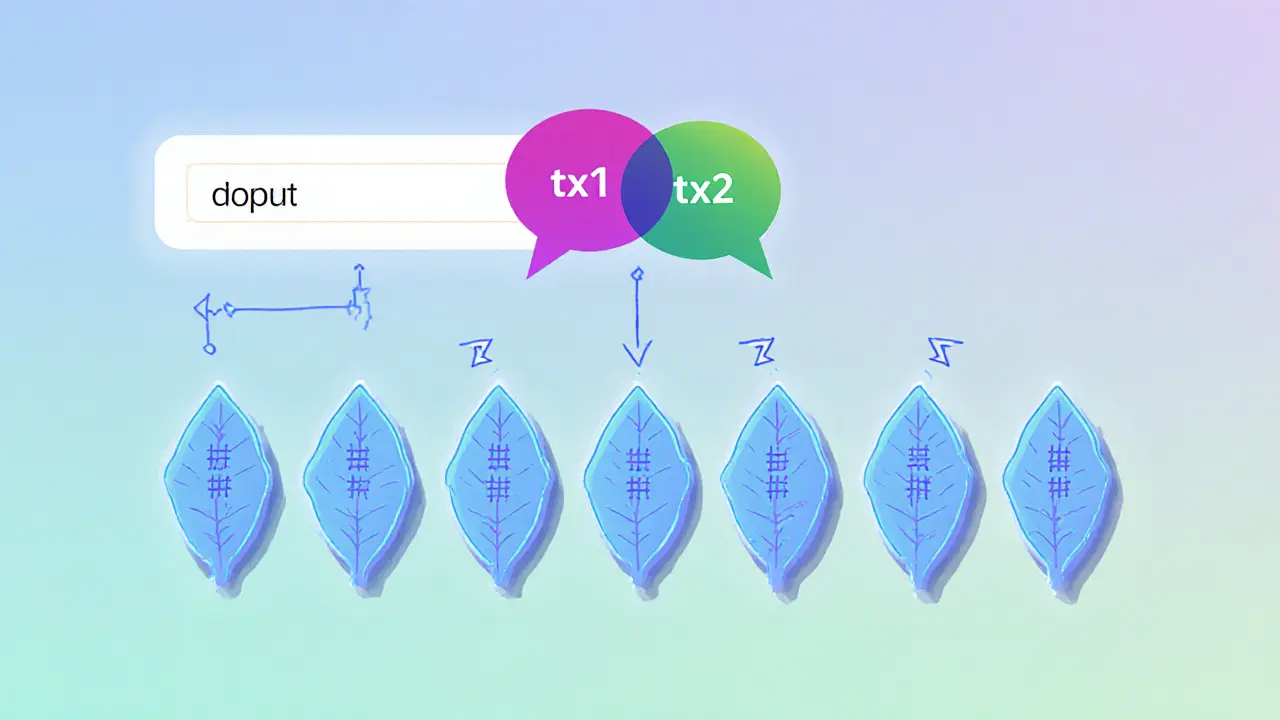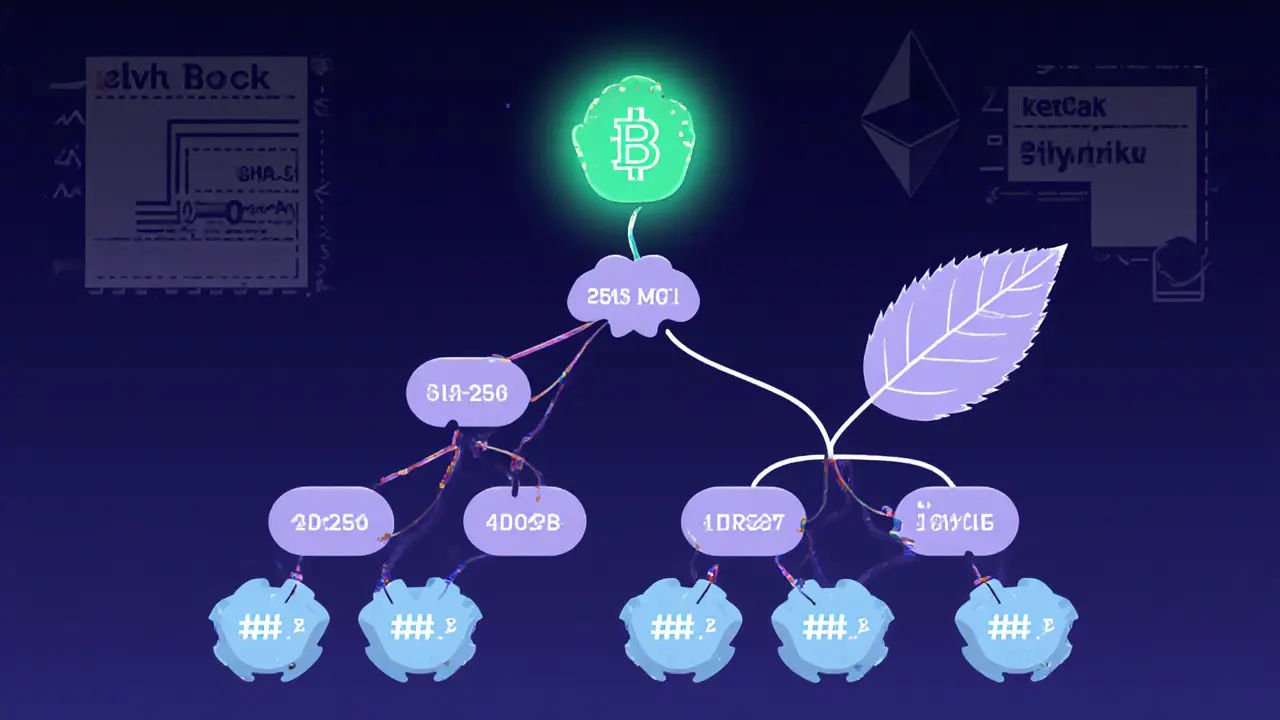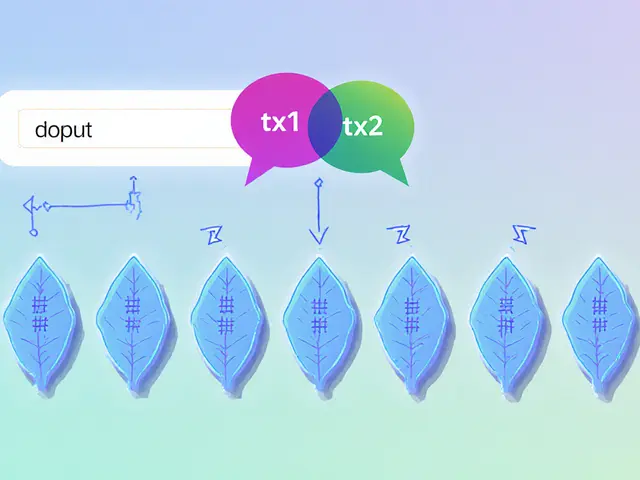- Home
- ::
- Merkle Trees Explained: How Blockchain Uses Hash Trees for Secure Verification

Merkle Trees Explained: How Blockchain Uses Hash Trees for Secure Verification
Merkle Tree Builder
Merkle Root:
When you hear Merkle trees are a type of cryptographic data structure that lets a blockchain prove that a transaction is in a block without needing to download the whole block. Each leaf node holds the hash of a single transaction, inner nodes hold the combined hash of their children, and the single top node - the Merkle root - acts as a digital fingerprint for the entire set of transactions.
Key Takeaways
- Merkle trees turn thousands of transactions into one short hash called the Merkle root.
- They enable lightweight verification called a Merkle proof, which only requires a few hashes.
- Bitcoin and Ethereum both use Merkle‑based structures, but the exact variant differs.
- Benefits include storage savings, fast verification, and tamper‑evidence.
- Limitations involve tree rebuilding for new data and difficulty proving non‑inclusion.
What Is a Merkle Tree?
A Merkle tree - also known as a hash tree or binary hash tree - is a binary data structure where every node stores a cryptographic hash. The lowest level, called leaf node contains the hash of an individual transaction or piece of data. Moving up, each parent node concatenates the hashes of its two children and hashes the result again. This process repeats until it reaches the single top node, the Merkle root a hash that uniquely represents the entire set of leaf values.
The tree’s binary nature means it always has an even number of leaves. When a block has an odd number of transactions, the last hash is duplicated so the tree stays balanced. This rule keeps the algorithm simple and deterministic.
How Merkle Trees Power Blockchain
In a blockchain each block a collection of transactions packaged together contains a header and a body. The header stores the Merkle root, while the body holds the raw transactions. When a node receives a new block, it hashes every transaction, builds the Merkle tree, and compares the calculated root with the one in the header. If they match, the block is valid.
Bitcoin uses the SHA‑256 hash function for every step of this process. After hashing each transaction, the network repeatedly applies SHA‑256 to the concatenated child hashes until the Merkle root is produced. The root is then written into the block header, which is also part of the proof‑of‑work algorithm.
Ethereum takes a slightly different route. It employs a Merkle Patricia tree a hybrid structure that combines a Merkle tree with a Patricia trie for efficient key‑value storage. This variant lets Ethereum store account balances, contract code, and storage slots in a single cryptographic proof, making state validation fast for light clients.
Why Use Merkle Trees?
There are three big advantages:
- Storage efficiency: Instead of keeping every transaction on‑chain, a node can store just the Merkle root and still verify the entire block.
- Fast verification: A Merkle proof requires only log₂(N) hashes, where N is the number of transactions. For a block with 2,000 transactions, a proof needs only about 11 hashes.
- Tamper evidence: Changing a single transaction alters its leaf hash, which propagates up the tree and changes the Merkle root. Any mismatch instantly signals corruption.
Lightweight wallets and SPV (Simplified Payment Verification) clients rely on these proofs to confirm that a payment was included without downloading the whole blockchain.

Limitations and Challenges
Merkle trees are not a silver bullet. Adding a new transaction means rebuilding the tree, which can be costly for high‑throughput systems. Also, the structure proves inclusion but does not easily prove that a transaction is absent. Developers must handle edge cases like odd leaf counts and duplicate hashes.
From a developer’s perspective, implementing a Merkle tree involves understanding cryptographic hashing, tree traversal, and proof verification. A basic implementation can be written in a week, but optimizing for millions of transactions per day often takes months of profiling and tweaking.
Variants and Emerging Trends
Beyond the classic binary version, several specialized trees are gaining traction:
- Merkle Patricia tree used by Ethereum for state storage - combines Merkle proofs with a prefix tree to handle sparse key spaces.
- Sparse Merkle tree a depth‑fixed tree that can represent billions of possible keys with only a few stored leaves - popular in privacy‑preserving protocols.
- Quantum‑resistant hash functions are being explored to future‑proof Merkle proofs against potential quantum attacks.
- Layer‑2 solutions such as rollups often bundle many transactions into a single Merkle root, then post a succinct proof to the main chain.
Practical Tips for Building Your Own Merkle Tree
If you need to add Merkle support to a project, follow these steps:
- Choose a hash algorithm (SHA‑256 is standard for Bitcoin, Keccak‑256 for Ethereum).
- Collect all transaction data and compute the leaf hashes.
- If the leaf count is odd, duplicate the last hash.
- Iteratively pair hashes, concatenate them, and hash the result until you reach a single hash - the Merkle root.
- Store the root in your block header and expose a function that returns the proof (list of sibling hashes) for a given transaction index.
Common pitfalls:
- Mixing byte order when concatenating hashes - always use big‑endian consistent with the target blockchain.
- Forgetting to duplicate the last leaf on odd‑sized trees - this creates mismatched roots.
- Not handling the case where a proof is requested for an index out of range - return a clear error.
Many open‑source libraries already implement these steps. The Bitcoin Core repository, for example, provides a well‑tested C++ class, while JavaScript developers can use the "merkletreejs" package.
Merkle Tree vs. Simple Transaction List
| Aspect | Simple Transaction List | Merkle Tree |
|---|---|---|
| On‑chain size | All transactions stored in the block body | Only the Merkle root stored in the header |
| Verification data needed | Full block download | Logarithmic number of hashes (Merkle proof) |
| Proof of inclusion | Not available without full block | Instant via Merkle proof |
| Impact of a single transaction change | Only that transaction is altered | Entire Merkle root changes, signaling tampering |
| Complexity to implement | Very low | Moderate - requires hashing and tree logic |

Frequently Asked Questions
Frequently Asked Questions
What exactly does a Merkle proof prove?
A Merkle proof shows that a specific transaction’s hash appears in a block’s Merkle tree by providing the sibling hashes needed to reconstruct the Merkle root. If the reconstructed root matches the one in the block header, the transaction is confirmed as part of the block.
Why does Bitcoin duplicate the last hash when there’s an odd number of transactions?
Duplicating the last leaf keeps the tree perfectly balanced, which simplifies the hashing algorithm. Without duplication, some branches would be deeper than others, breaking the deterministic nature of the Merkle root.
Can a Merkle tree prove that a transaction is NOT in a block?
Standard Merkle trees are designed for inclusion proofs, not exclusion. To prove non‑inclusion you need a different structure, such as a sparse Merkle tree or a Merkle‑Patricia proof that can show an empty slot at a given index.
Is the Merkle root always stored in a block header?
Yes. In both Bitcoin and Ethereum the Merkle root (or its variant) is part of the block header, making it quick for nodes to verify the integrity of the whole transaction set without opening the full block.
How do Layer‑2 rollups use Merkle trees?
Rollups batch many transactions off‑chain, compute a Merkle root for the batch, and then post that single root to the main chain. A concise proof lets anyone verify any individual transaction inside the batch without pulling the whole rollup data.


 Finance
Finance





Write a comment